admin
Staff member
Suzuki has been riding along, if you’ll pardon the pun, on the same platforms for its bikes for at least a decade now. The GSX-R’s with their parallel twins or inline fours, the V-Stroms and the SV650 with the beginner friendly V-twin, and their cruiser lineup of simple but effective Boulevard bikes. Now, however, they’ve taken the budget from their recently-ended racing program, and reinvested it into new platforms and new bikes for 2023 and beyond.
One of those new platforms is the all-new 776cc, 270-degree crank parallel twin engine, which makes its debut in the 2023 V-Strom 800DE and the GSX-8S bikes. Also debuting with these bikes is an all-new TFT dash and software for said dash, and the biggest new thing, the SIRS safety and comfort system. SIRS stands for Suzuki Intelligent Ride System, and automatically adjusts ABS, TC, suspension (if electronically controlled, which it isn’t on the 8S), and stability control depending on which ride mode you are in, as well as feedback from a whole slew of sensors to make hundreds of adjustments per second.
I had the chance, thanks to Suzuki Canada and Barnes Powersports Blackfoot, to spend just about an hour with a GSX-8S on June 15, 2023. The bike I rode is so new, it’s not even fully through its factory break-in mileage! The ride was done on a varied selection of roads, including twisty roads, rough roads, a short blast on the local equivalent of a freeway, and multiple opportunities to open it up a little to see just how it rode and responded.
After signing in with the Suzuki rep’s table and verifying that I am, indeed, licensed to ride on two wheels, I was able to spend a little bit of time getting to know the GSX-8S a bit better. Suzuki labels it as a streetfighter as well as a sport naked, but on first impression, I will say that it’s more a junior streetfighter than on either extreme pole of that range from looks alone.
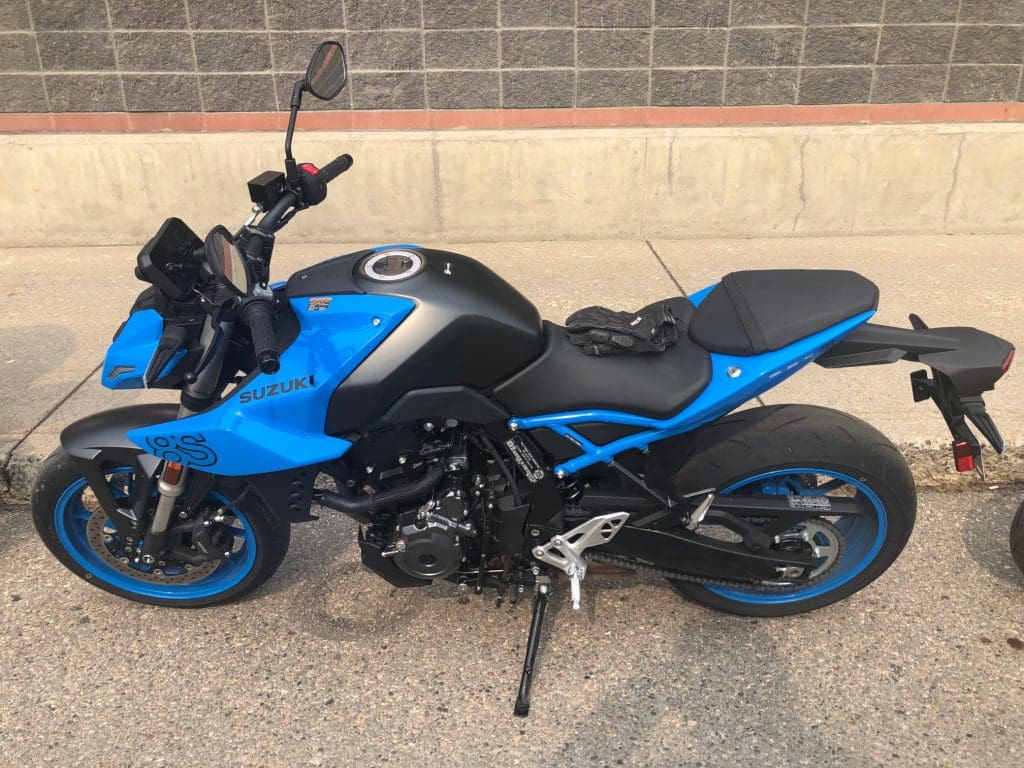

Pardon me leaving my gloves on the seat! The GSX-8S does look very taut and small, but it is in fact longer than your average Kawasaki Ninja sport bike, thanks to that long swingarm and short pillion overhang.
Pictures do not convey how taut and ready to go it looks in three dimensions, however. In person, it is an angular, angry looking thing, with a bit of exposed framework to flex its muscles a little. The swingarm is big, chunky, purposeful, and the hawk-like beak at the front cowling just adds to the aesthetic of this bike being ready to take a bite out of the competition. One thing that is very misleading about the bike is that in pictures, and even across the road from it, it looks tiny.
It looks like it’s tensed up and at the first flick of the wrist will lash out with a punch or kick, which is part of the charm about it, but the reality is that it is longer than my own personal bike, a 2012 Kawasaki Ninja 650 by at least two inches. This is partly down to the very short pillion seat and rear overhang, as well as the front cowl being pulled back almost in line with the front forks. Yet, it boasts a wheelbase of 57.5 inches, compared to the Ninja 650’s 55.1 inches, and matches the seat height at just under 32 inches.
One thing that you do notice up close is how Suzuki have tucked the exhaust quite tightly under the bottom of the bike, with the tip of it angled up and out behind the right foot peg. With probably the smallest muffler I’ve ever seen stock on a new bike, it could even be generously called “Stealthy,” although I suspect that the reason for its placement and angle is that Suzuki bikes have a massive third-party aftermarket scene.
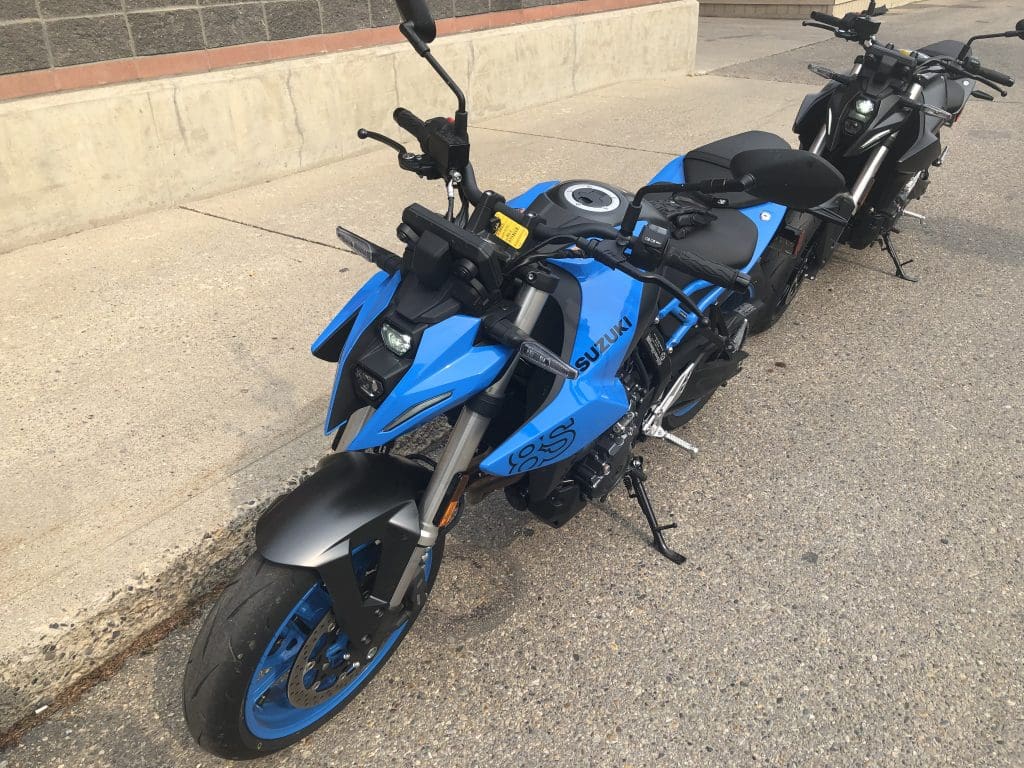

The two GSX-8S bikes for the demo day. I think the blue pops a lot more than the matte black, but some people do like the stealthier look. Personal opinions vary, and there is also a white colorway as well.
Another thing that you notice as you walk around the bike and get used to how it looks is just how tidy it is. What I mean by this is that some bikes have little flashes and flairs of bodywork or extraneous bits added for style, while the GSX-8S doesn’t seem to have a bit out of place. Everything has a purpose, and even the support that holds the wiring for the TFT dash is integrated into the headlight cover, with two LED headlights stacked vertically for a thin, pointed look up front.
Speaking of the dash, it’s right about middle of the road in terms of clutter. The tachometer, gear, and speed are the three biggest parts of the display, and honestly would look good on their own, but there is some clutter around them that, while informative, makes the dash look cramped. It’s not downright bad, just… busy. The tach doesn’t need to take up half the screen, but it does give a mildly analog feel to the digital dash.
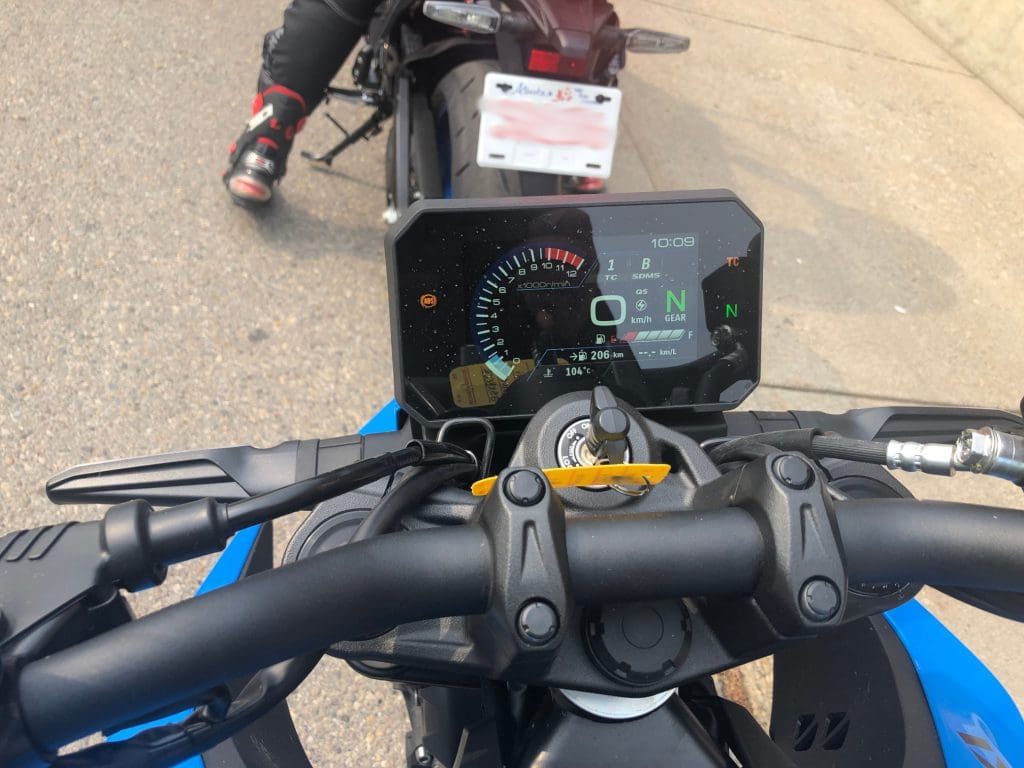

A little cluttered, but the important bits are big and in your face. I would have liked to have seen an option to switch the dash to a “Track mode” or some such, with just the tach, speed, and gear readouts, but it is perfectly usable as is
What I do appreciate, however, is how clean the handlebars and grips are. Suzuki has a brilliant little thumb box on the left hand side that puts the indicator and horn right in line with your thumb for easy use, with a rocker switch and separate button to scroll menus and select things above those controls. Out of the way, but still easily reached with just twisting your left wrist forward half an inch, and has really chunky, positive clicks on all buttons so you know you’ve pressed it, even through gloves.
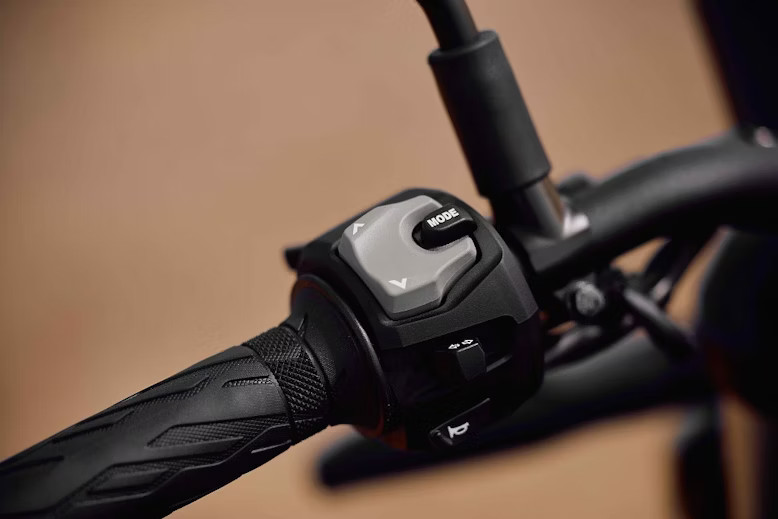

The ridiculously well designed left button box. That big rocker switch with the mode button in the middle of it has very positive haptics, and you can feel it with your glove without looking, great for paying attention to the road if you need to change riding modes to the slippery/wet C-mode on the fly. Image via RevZilla
As it was time to get on and go ride, the last bit of the pre-ride inspection I did was how the seat feels. As this is positioned as a streetfighter, and with a low slung fuel tank, I was expecting to find a stiff supersport seat. To my surprise, while it was firm, it was also very comfortable. I measure comfort by how easily I can sit on a saddle without my tailbone complaining, and it remained silent as I settled onto the seat, picked up the bike, and flicked up the kickstand.
One thing that is apparent about the GSX-8S right away is that it does not feel anything like its 445 lbs wet weight. There have been times on some bikes when moving off, leaning into a corner, or during acceleration or braking that I have felt like the bike I am on weighs as much as it claims. With the Suzuki, there was definitely some weight to it, but it felt more like a dual-sport or even a DR-Z400SM supermoto in terms of weight.
That supermoto-style feel comes across in the way that the bike balances. Even during the times on the ride that I was in a first gear, slow-speed, clutch-and-rear brake crawl, I was barely inputting any steering angle, and my foot only touched down on the ground about a second after the bike came to a stop at a red light. At average road speed, it lined up exactly where I wanted it to be on the road, and there was no upper body lean, or even bike lean, to keep it on the straight and narrow.
It also feels like a supermoto in terms of power delivery. The Suzuki rep at the demo ride event told me that the engine has been designed to feel every bit as powerful and torque-y as the V-twin from the SV650, and having ridden one before, I would say it’s quite close. In fact, to me at least, it feels like it has a lot more from the mid-range on up, which makes sense as the claimed 82 HP arrives at 8,500 RPM.
The torque that comes from that 776cc parallel twin, however, is damned impressive. Moving off from a stop sign or red light, it definitely has an almighty shove to get you going, so much so that I even had the traction control briefly flash on the dash moving off from the first stop sign 30 seconds into the ride, as I had put a touch too much throttle in. I was in A-mode, the full on, balls-to-the-wall, hardcore streetfighter setting for the first bit of the ride, but even when I flicked it down to B-mode later on, the “Comfort” mode for regular street riding, that torque was still there way down in the depths of the rev range.
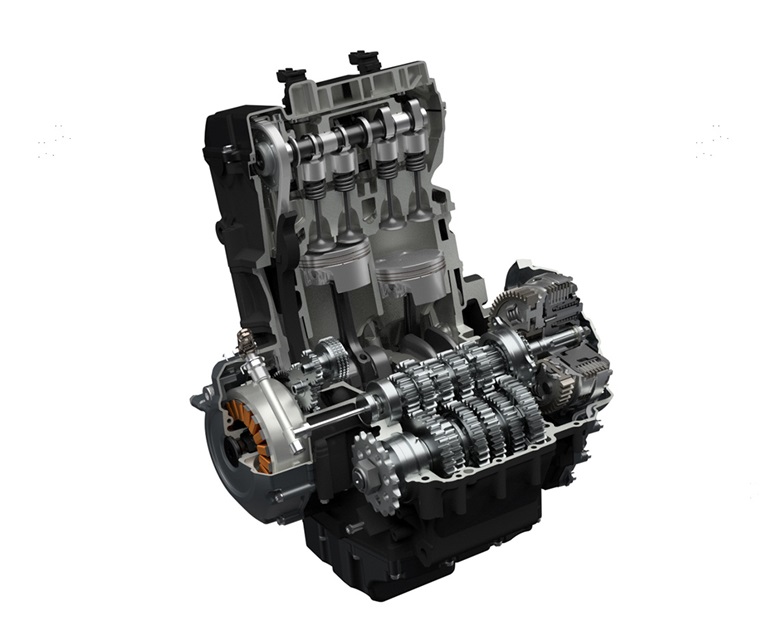

The all-new-for-2023 beating heart of the GSX-8S in cutaway. The 270 degree crank gives it a great burble, and that transmission is superb, especially the clutch feel! Image via Suzuki Media
On the subject of riding modes, this is where I found my first negative of the GSX-8S. There is a huge gap between A-mode and B-mode, with a power limiting, all assists turned up to 11 C-mode for wet or slippery riding. In A-mode, I would generously call the throttle response, as it is throttle-by-wire, “twitchy” in that after you have ¼ turn cranked on, every millimeter of twist added or removed is instantly translated to the engine. It is extremely aggressive, and as A-mode is meant for when you’re carving canyon corners or ripping around a track, it feels a bit too twitchy for in-city riding.
B-mode, on the other hand, feels a bit numb. I switched modes at a stop light halfway through the ride route, and even giving the throttle a test twist with the clutch in, I could feel the response being much more progressive and not as in-your-face-let’s-go-racing-right-now as A-mode. That was proven when moving off, as in A-mode I was able to slip the clutch and move at about ⅛ throttle twist, and I had to go up to about ⅙ to ¼ twist to move off in B-mode. It is a much more sensible mode for city riding, but to my wrist, it felt like it was playing it a bit too safe for a naked sport.
Mentioning the clutch, and bringing things back to the positive side of the bike, it was an absolutely joy to operate. In a market where everyone and their mother is moving to hydraulic clutches, even on “cheap” motorcycles, Suzuki has fitted a properly old-school cable-operated wet clutch on the GSX-8S. It is a slipper/assist clutch, but the feedback through the lever, which is also very light and can be operated with just one finger, is superb. The friction point is immediately communicated, and slipping the clutch for low-speed crawling is effortless, as you know just how much slip you need by the way the lever talks to you the whole time.
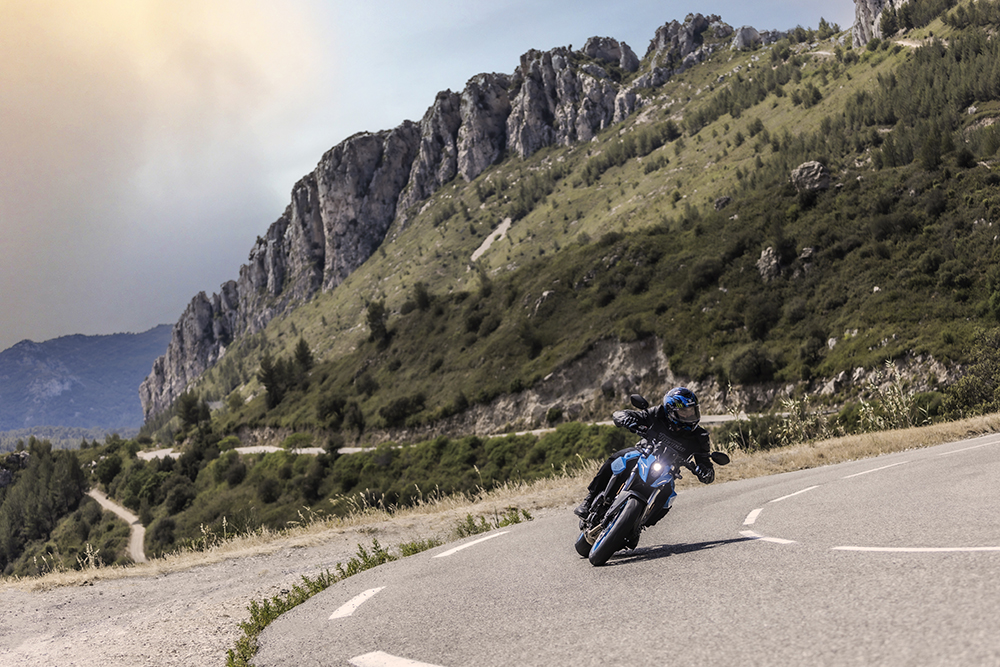

Getting your lean on at decent speeds is not at all difficult with the GSX-8S, and it does have a confident, if slightly numb, feel to it. Image via Suzuki Global Media
Something else that Suzuki has done a superb job with is the quickshifter, which is a standard feature on the GSX-8S. I must preface this section with the fact that the Suzuki rep instructed me on how to get the most out of the quickshifter. It works like any other quickshifter out there if you want to just kick up/kick down, and the downshifts done this way are slightly jerky and even a bit delayed in lower gears. The other way it works, however, is what the rep called “preloading,” and I have to say that it impressed the hell out of me.
Instead of kicking up or down all the way, you put pressure on the lever for an instant, literally less time than it takes to blink, and then kick up or down. Because of SIRS, those milliseconds of pressure tells the computer that you are going to shift, and it starts continuously calculating the exact revs it needs, almost like a dual-clutch gearbox on a car. When you finally do kick the lever, it instantly responds, and it is nigh-on imperceptible with how fast it changes gear. I even had to glance down at the dash the first time I tried it to make sure the gear had actually changed. The downshifts were smooth even with a tiny bit of throttle still cranked on, and imperceptible when fully off the throttle and braking.
As much as I am heaping the good onto the GSX-8S, there were a couple of very serious, deal-breaker issues that reared their head in the latter half of the demo ride. The first of these issues is that if you get the GSX-8S in any sort of high-wind situation, such as riding into a strong headwind or a decent crosswind, the lack of wind deflection and more importantly wind shaping makes the bike dance around. This was especially apparent when the demo ride went onto the expressway here (what Americans would call a freeway), and it was wanting to dance across the entire lane, and I had to put some decent inputs into it to keep it straight. It wasn’t enough to go full squeaky-bum clench, but compared to a sportbike or adventure tourer, it was definitely not the most pleasant thing I’ve ever done.
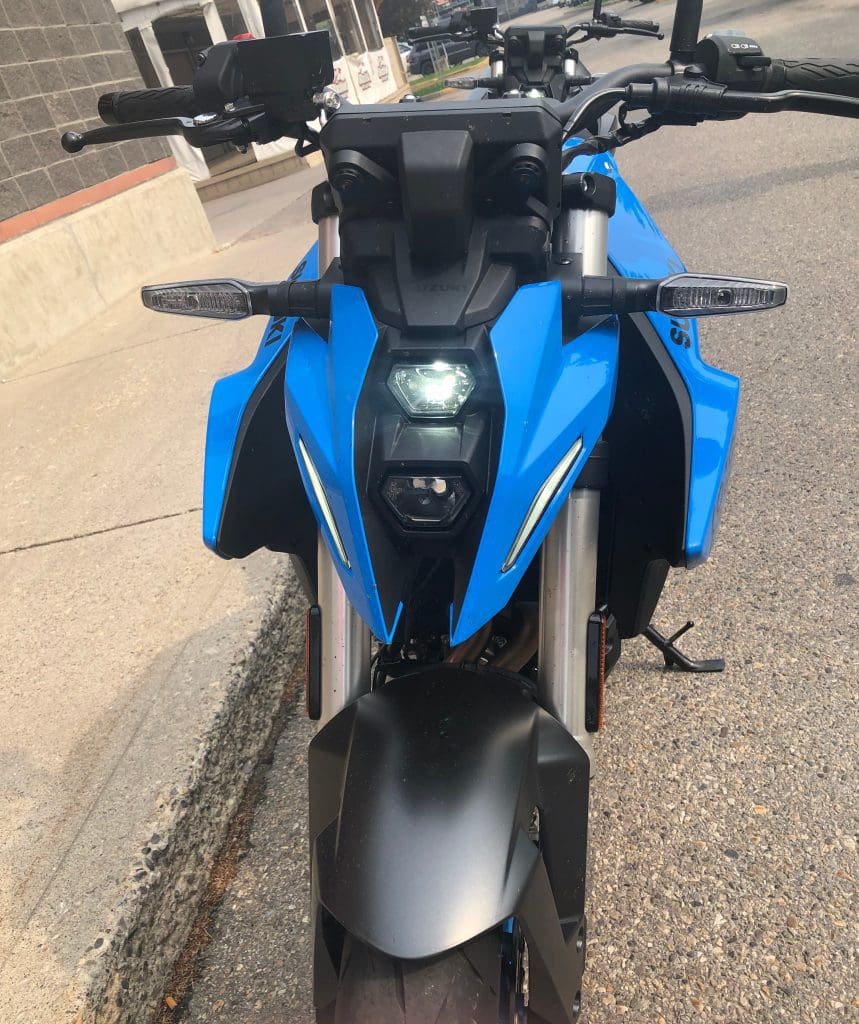

The front of the GSX-8S with the stacked LED headlights. Those two fender flares below the handlebars are the only wind deflection the bike has, and even then, it is quite susceptible to winds at higher speeds to the point it wants to dance around.
The second thing that came about was that the more the speed increased, it seemed that there was an inverse correlation to how much information the suspension and tires informed me about the road. At normal city speeds, namely 50 KPH (~30 MPH), it wasn’t telepathic, but it did communicate enough about the grip and the road beneath me that I felt confident and comfortable chucking it around a corner. When we got onto the 80 KPH (~50 MPH) road, the bike did feel a little more numb under me. It was riding well, and I was still confident and comfortable, but there was a noticeable lack of feeling regarding the rear end and the grip the tire had.
On the expressway, between 100 to 110 KPH (60 to ~68 MPH), I had no feeling about the rear end at all, and the front was becoming fairly numb. This is surprising to me because the GSX-8S has KYB inverted forks up front and a KYB preload-adjustable monoshock at the rear, and yet there was a definite lack of feel as the speed went up. I don’t know if it was because of the tires, Dunlop Sportmax Roadsport 2’s, or that the suspension was just that vague, but whatever the reason, it was quite disconcerting.
Update June 23: After speaking with other reviewers and riders that have had more time with the GSX-8S, the numbness of the ride is not because of the suspension, and so my verdict has been updated. The issue at hand is that the Dunlop Sportmax Roadsport 2 tires are reported to be to be extremely vague in their grip until they are fully scrubbed in and have some wear on them. As the GSX-8S I was riding had just over 350 KM on its odometer (just about 217 miles), the tires on it could be considered brand new, especially as they were on a demo bike that had only occasional riding done on it. This was backed up by an owner I contacted via the Gixxer.com motorcycle forums that reported that after about 350 miles of riding over a couple of days, the tires and suspension became very communicative and provided good grip front and rear.
The Suzuki GSX-8S, all said and done, is what I would call a perfectly acceptable in-city sport naked. Depending on the riding mode, it can be a comfortable runabout to get you to and from work or over to your buddy’s place, or it can be a ripsnorting beast that begs to be shown some corners. As a bike of two personalities, it does manage to balance both decently, although it is not a perfect bike.
It has a lot going for it. It has torque for days all over the lower half of the rev range where 95% of riding uses it, and it has a clutch that is approaching divine. It eagerly corners and has great balance on city roads. It has a quickshifter that actually works like how 99% of people want one to work, and has a neat little preload feature that makes the shifts smoother than butter. It has a very comfortable sport-standard seating layout, and I can see it being comfortable for multiple hours of riding, as the pegs aren’t too far back and up as they can be on sport bikes.
The aggravating factors are serious, however, and must weigh in on the overall thoughts of the GSX-8S. The lack of feel at higher speeds is probably the most serious, although after talking with owners over the week since I rode the demo bike, that comes down to the OEM tires taking some time to wear in and get to the grippier rubber under the sealant coating. Since this is the case, if you are looking to buy a GSX-8S, ride it at city speeds for the first few hundred miles and scrub the tires in properly, or if you want, change out the OEM tires for your preferred street tires and keep the rubber as spares.
The throttle twitchiness when riding in A-mode is livable, and with more seat time I probably would have adjusted to it without issue, but for someone without a properly installed idiot filter between brain and wrist, it could be surprising with just how much power the bike likes to dump to the rear wheel even on ¼ throttle. I could honestly see an unintentionally wheelie or even looping the bike possible for someone that gets crazy with their right wrist. Counter to that, B-mode feels… I think the best word is “unenthused.” It’s acceptable, even comfortable, but it doesn’t give the GSX-8S that exciting edge a sport bike should, especially if it’s being marketed as a streetfighter, even a junior one.
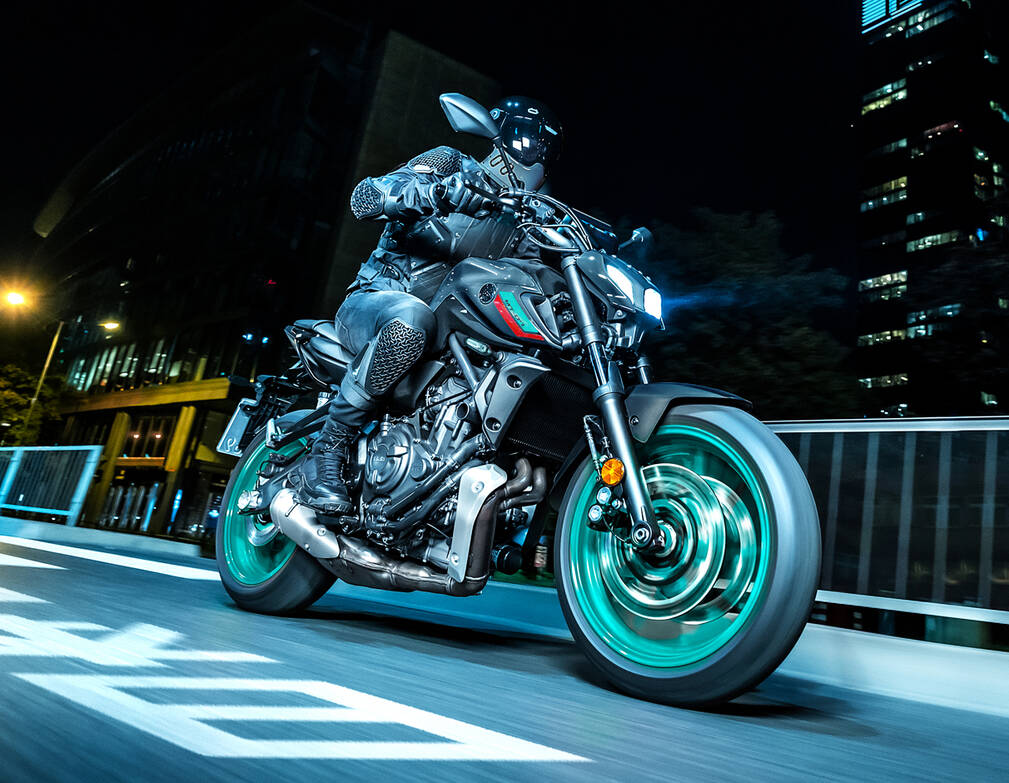

The GSX-8S primary nemesis, the Yamaha MT-07. Both bikes are under $10,000 and and parallel twins, with very close power numbers. Image via Yamaha Global Media
There are better bikes by far in this price and power range. The Yamaha MT-07 is probably the closest competition, and it is lighter by a good 40 lbs but somehow feels much more planted than the GSX-8S. Another challenger is in the form of the KTM 890 Duke, which is a streetfighter through and through. However, both of those bikes are much more expensive, to the tune of nearly $2,000 to $4,000, than the Suzuki, and the GSX-8S has its quickshifter as standard, an option on the much pricier KTM.
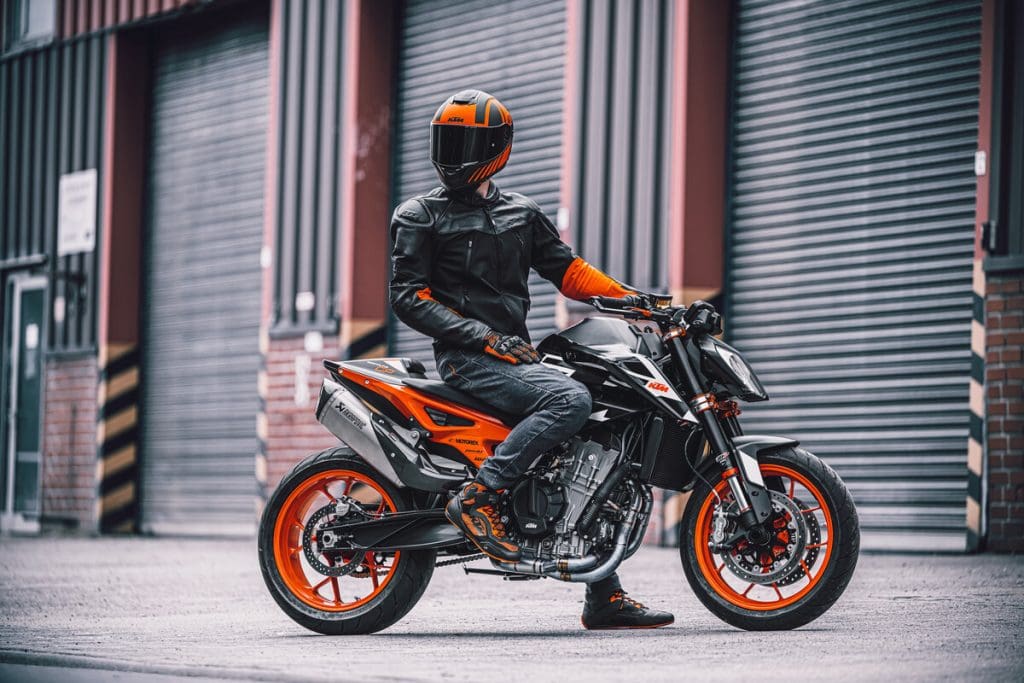

The other major competitor to the GSX-8S, at least in the “800 to 900 cc” class, the 2023 KTM 890 Duke. The KTM is much more expensive, a heck of a lot more powerful, and is a pure streetfighter through and through. Definitely not nearly as beginner friendly as the Suzuki. Image via KTM
The fact I’m even mentioning the MT-07 and 890 Duke shows that I do respect the GSX-8S for what it is. It’s not as in-your-face exciting and aggressive as either of those bikes, but that, I think, is precisely the point. It’s perfectly suited to urban environments and the occasional run at the twisties, and I think it would make a superb commuter, especially as one of the options for the bike is a set of pannier lockers.
I think the best way I can summarize the GSX-8S is as a very good bike that isn’t as scary as those other two mentioned above. It’s approachable, rideable, and if they can fix the suspension vagueness at higher speeds, I would probably recommend it as a first bike at the same level as an SV650.
The post 2023 Suzuki GSX-8S: First Impressions appeared first on webBikeWorld.
Continue reading...
One of those new platforms is the all-new 776cc, 270-degree crank parallel twin engine, which makes its debut in the 2023 V-Strom 800DE and the GSX-8S bikes. Also debuting with these bikes is an all-new TFT dash and software for said dash, and the biggest new thing, the SIRS safety and comfort system. SIRS stands for Suzuki Intelligent Ride System, and automatically adjusts ABS, TC, suspension (if electronically controlled, which it isn’t on the 8S), and stability control depending on which ride mode you are in, as well as feedback from a whole slew of sensors to make hundreds of adjustments per second.
I had the chance, thanks to Suzuki Canada and Barnes Powersports Blackfoot, to spend just about an hour with a GSX-8S on June 15, 2023. The bike I rode is so new, it’s not even fully through its factory break-in mileage! The ride was done on a varied selection of roads, including twisty roads, rough roads, a short blast on the local equivalent of a freeway, and multiple opportunities to open it up a little to see just how it rode and responded.
Before The Ride
After signing in with the Suzuki rep’s table and verifying that I am, indeed, licensed to ride on two wheels, I was able to spend a little bit of time getting to know the GSX-8S a bit better. Suzuki labels it as a streetfighter as well as a sport naked, but on first impression, I will say that it’s more a junior streetfighter than on either extreme pole of that range from looks alone.


Pardon me leaving my gloves on the seat! The GSX-8S does look very taut and small, but it is in fact longer than your average Kawasaki Ninja sport bike, thanks to that long swingarm and short pillion overhang.
Pictures do not convey how taut and ready to go it looks in three dimensions, however. In person, it is an angular, angry looking thing, with a bit of exposed framework to flex its muscles a little. The swingarm is big, chunky, purposeful, and the hawk-like beak at the front cowling just adds to the aesthetic of this bike being ready to take a bite out of the competition. One thing that is very misleading about the bike is that in pictures, and even across the road from it, it looks tiny.
It looks like it’s tensed up and at the first flick of the wrist will lash out with a punch or kick, which is part of the charm about it, but the reality is that it is longer than my own personal bike, a 2012 Kawasaki Ninja 650 by at least two inches. This is partly down to the very short pillion seat and rear overhang, as well as the front cowl being pulled back almost in line with the front forks. Yet, it boasts a wheelbase of 57.5 inches, compared to the Ninja 650’s 55.1 inches, and matches the seat height at just under 32 inches.
One thing that you do notice up close is how Suzuki have tucked the exhaust quite tightly under the bottom of the bike, with the tip of it angled up and out behind the right foot peg. With probably the smallest muffler I’ve ever seen stock on a new bike, it could even be generously called “Stealthy,” although I suspect that the reason for its placement and angle is that Suzuki bikes have a massive third-party aftermarket scene.


The two GSX-8S bikes for the demo day. I think the blue pops a lot more than the matte black, but some people do like the stealthier look. Personal opinions vary, and there is also a white colorway as well.
Another thing that you notice as you walk around the bike and get used to how it looks is just how tidy it is. What I mean by this is that some bikes have little flashes and flairs of bodywork or extraneous bits added for style, while the GSX-8S doesn’t seem to have a bit out of place. Everything has a purpose, and even the support that holds the wiring for the TFT dash is integrated into the headlight cover, with two LED headlights stacked vertically for a thin, pointed look up front.
Speaking of the dash, it’s right about middle of the road in terms of clutter. The tachometer, gear, and speed are the three biggest parts of the display, and honestly would look good on their own, but there is some clutter around them that, while informative, makes the dash look cramped. It’s not downright bad, just… busy. The tach doesn’t need to take up half the screen, but it does give a mildly analog feel to the digital dash.


A little cluttered, but the important bits are big and in your face. I would have liked to have seen an option to switch the dash to a “Track mode” or some such, with just the tach, speed, and gear readouts, but it is perfectly usable as is
What I do appreciate, however, is how clean the handlebars and grips are. Suzuki has a brilliant little thumb box on the left hand side that puts the indicator and horn right in line with your thumb for easy use, with a rocker switch and separate button to scroll menus and select things above those controls. Out of the way, but still easily reached with just twisting your left wrist forward half an inch, and has really chunky, positive clicks on all buttons so you know you’ve pressed it, even through gloves.


The ridiculously well designed left button box. That big rocker switch with the mode button in the middle of it has very positive haptics, and you can feel it with your glove without looking, great for paying attention to the road if you need to change riding modes to the slippery/wet C-mode on the fly. Image via RevZilla
As it was time to get on and go ride, the last bit of the pre-ride inspection I did was how the seat feels. As this is positioned as a streetfighter, and with a low slung fuel tank, I was expecting to find a stiff supersport seat. To my surprise, while it was firm, it was also very comfortable. I measure comfort by how easily I can sit on a saddle without my tailbone complaining, and it remained silent as I settled onto the seat, picked up the bike, and flicked up the kickstand.
The Ride
One thing that is apparent about the GSX-8S right away is that it does not feel anything like its 445 lbs wet weight. There have been times on some bikes when moving off, leaning into a corner, or during acceleration or braking that I have felt like the bike I am on weighs as much as it claims. With the Suzuki, there was definitely some weight to it, but it felt more like a dual-sport or even a DR-Z400SM supermoto in terms of weight.
That supermoto-style feel comes across in the way that the bike balances. Even during the times on the ride that I was in a first gear, slow-speed, clutch-and-rear brake crawl, I was barely inputting any steering angle, and my foot only touched down on the ground about a second after the bike came to a stop at a red light. At average road speed, it lined up exactly where I wanted it to be on the road, and there was no upper body lean, or even bike lean, to keep it on the straight and narrow.
It also feels like a supermoto in terms of power delivery. The Suzuki rep at the demo ride event told me that the engine has been designed to feel every bit as powerful and torque-y as the V-twin from the SV650, and having ridden one before, I would say it’s quite close. In fact, to me at least, it feels like it has a lot more from the mid-range on up, which makes sense as the claimed 82 HP arrives at 8,500 RPM.
The torque that comes from that 776cc parallel twin, however, is damned impressive. Moving off from a stop sign or red light, it definitely has an almighty shove to get you going, so much so that I even had the traction control briefly flash on the dash moving off from the first stop sign 30 seconds into the ride, as I had put a touch too much throttle in. I was in A-mode, the full on, balls-to-the-wall, hardcore streetfighter setting for the first bit of the ride, but even when I flicked it down to B-mode later on, the “Comfort” mode for regular street riding, that torque was still there way down in the depths of the rev range.


The all-new-for-2023 beating heart of the GSX-8S in cutaway. The 270 degree crank gives it a great burble, and that transmission is superb, especially the clutch feel! Image via Suzuki Media
On the subject of riding modes, this is where I found my first negative of the GSX-8S. There is a huge gap between A-mode and B-mode, with a power limiting, all assists turned up to 11 C-mode for wet or slippery riding. In A-mode, I would generously call the throttle response, as it is throttle-by-wire, “twitchy” in that after you have ¼ turn cranked on, every millimeter of twist added or removed is instantly translated to the engine. It is extremely aggressive, and as A-mode is meant for when you’re carving canyon corners or ripping around a track, it feels a bit too twitchy for in-city riding.
B-mode, on the other hand, feels a bit numb. I switched modes at a stop light halfway through the ride route, and even giving the throttle a test twist with the clutch in, I could feel the response being much more progressive and not as in-your-face-let’s-go-racing-right-now as A-mode. That was proven when moving off, as in A-mode I was able to slip the clutch and move at about ⅛ throttle twist, and I had to go up to about ⅙ to ¼ twist to move off in B-mode. It is a much more sensible mode for city riding, but to my wrist, it felt like it was playing it a bit too safe for a naked sport.
Mentioning the clutch, and bringing things back to the positive side of the bike, it was an absolutely joy to operate. In a market where everyone and their mother is moving to hydraulic clutches, even on “cheap” motorcycles, Suzuki has fitted a properly old-school cable-operated wet clutch on the GSX-8S. It is a slipper/assist clutch, but the feedback through the lever, which is also very light and can be operated with just one finger, is superb. The friction point is immediately communicated, and slipping the clutch for low-speed crawling is effortless, as you know just how much slip you need by the way the lever talks to you the whole time.


Getting your lean on at decent speeds is not at all difficult with the GSX-8S, and it does have a confident, if slightly numb, feel to it. Image via Suzuki Global Media
Something else that Suzuki has done a superb job with is the quickshifter, which is a standard feature on the GSX-8S. I must preface this section with the fact that the Suzuki rep instructed me on how to get the most out of the quickshifter. It works like any other quickshifter out there if you want to just kick up/kick down, and the downshifts done this way are slightly jerky and even a bit delayed in lower gears. The other way it works, however, is what the rep called “preloading,” and I have to say that it impressed the hell out of me.
Instead of kicking up or down all the way, you put pressure on the lever for an instant, literally less time than it takes to blink, and then kick up or down. Because of SIRS, those milliseconds of pressure tells the computer that you are going to shift, and it starts continuously calculating the exact revs it needs, almost like a dual-clutch gearbox on a car. When you finally do kick the lever, it instantly responds, and it is nigh-on imperceptible with how fast it changes gear. I even had to glance down at the dash the first time I tried it to make sure the gear had actually changed. The downshifts were smooth even with a tiny bit of throttle still cranked on, and imperceptible when fully off the throttle and braking.
As much as I am heaping the good onto the GSX-8S, there were a couple of very serious, deal-breaker issues that reared their head in the latter half of the demo ride. The first of these issues is that if you get the GSX-8S in any sort of high-wind situation, such as riding into a strong headwind or a decent crosswind, the lack of wind deflection and more importantly wind shaping makes the bike dance around. This was especially apparent when the demo ride went onto the expressway here (what Americans would call a freeway), and it was wanting to dance across the entire lane, and I had to put some decent inputs into it to keep it straight. It wasn’t enough to go full squeaky-bum clench, but compared to a sportbike or adventure tourer, it was definitely not the most pleasant thing I’ve ever done.


The front of the GSX-8S with the stacked LED headlights. Those two fender flares below the handlebars are the only wind deflection the bike has, and even then, it is quite susceptible to winds at higher speeds to the point it wants to dance around.
The second thing that came about was that the more the speed increased, it seemed that there was an inverse correlation to how much information the suspension and tires informed me about the road. At normal city speeds, namely 50 KPH (~30 MPH), it wasn’t telepathic, but it did communicate enough about the grip and the road beneath me that I felt confident and comfortable chucking it around a corner. When we got onto the 80 KPH (~50 MPH) road, the bike did feel a little more numb under me. It was riding well, and I was still confident and comfortable, but there was a noticeable lack of feeling regarding the rear end and the grip the tire had.
On the expressway, between 100 to 110 KPH (60 to ~68 MPH), I had no feeling about the rear end at all, and the front was becoming fairly numb. This is surprising to me because the GSX-8S has KYB inverted forks up front and a KYB preload-adjustable monoshock at the rear, and yet there was a definite lack of feel as the speed went up. I don’t know if it was because of the tires, Dunlop Sportmax Roadsport 2’s, or that the suspension was just that vague, but whatever the reason, it was quite disconcerting.
The Verdict
Update June 23: After speaking with other reviewers and riders that have had more time with the GSX-8S, the numbness of the ride is not because of the suspension, and so my verdict has been updated. The issue at hand is that the Dunlop Sportmax Roadsport 2 tires are reported to be to be extremely vague in their grip until they are fully scrubbed in and have some wear on them. As the GSX-8S I was riding had just over 350 KM on its odometer (just about 217 miles), the tires on it could be considered brand new, especially as they were on a demo bike that had only occasional riding done on it. This was backed up by an owner I contacted via the Gixxer.com motorcycle forums that reported that after about 350 miles of riding over a couple of days, the tires and suspension became very communicative and provided good grip front and rear.
The Suzuki GSX-8S, all said and done, is what I would call a perfectly acceptable in-city sport naked. Depending on the riding mode, it can be a comfortable runabout to get you to and from work or over to your buddy’s place, or it can be a ripsnorting beast that begs to be shown some corners. As a bike of two personalities, it does manage to balance both decently, although it is not a perfect bike.
It has a lot going for it. It has torque for days all over the lower half of the rev range where 95% of riding uses it, and it has a clutch that is approaching divine. It eagerly corners and has great balance on city roads. It has a quickshifter that actually works like how 99% of people want one to work, and has a neat little preload feature that makes the shifts smoother than butter. It has a very comfortable sport-standard seating layout, and I can see it being comfortable for multiple hours of riding, as the pegs aren’t too far back and up as they can be on sport bikes.
The aggravating factors are serious, however, and must weigh in on the overall thoughts of the GSX-8S. The lack of feel at higher speeds is probably the most serious, although after talking with owners over the week since I rode the demo bike, that comes down to the OEM tires taking some time to wear in and get to the grippier rubber under the sealant coating. Since this is the case, if you are looking to buy a GSX-8S, ride it at city speeds for the first few hundred miles and scrub the tires in properly, or if you want, change out the OEM tires for your preferred street tires and keep the rubber as spares.
The throttle twitchiness when riding in A-mode is livable, and with more seat time I probably would have adjusted to it without issue, but for someone without a properly installed idiot filter between brain and wrist, it could be surprising with just how much power the bike likes to dump to the rear wheel even on ¼ throttle. I could honestly see an unintentionally wheelie or even looping the bike possible for someone that gets crazy with their right wrist. Counter to that, B-mode feels… I think the best word is “unenthused.” It’s acceptable, even comfortable, but it doesn’t give the GSX-8S that exciting edge a sport bike should, especially if it’s being marketed as a streetfighter, even a junior one.


The GSX-8S primary nemesis, the Yamaha MT-07. Both bikes are under $10,000 and and parallel twins, with very close power numbers. Image via Yamaha Global Media
There are better bikes by far in this price and power range. The Yamaha MT-07 is probably the closest competition, and it is lighter by a good 40 lbs but somehow feels much more planted than the GSX-8S. Another challenger is in the form of the KTM 890 Duke, which is a streetfighter through and through. However, both of those bikes are much more expensive, to the tune of nearly $2,000 to $4,000, than the Suzuki, and the GSX-8S has its quickshifter as standard, an option on the much pricier KTM.


The other major competitor to the GSX-8S, at least in the “800 to 900 cc” class, the 2023 KTM 890 Duke. The KTM is much more expensive, a heck of a lot more powerful, and is a pure streetfighter through and through. Definitely not nearly as beginner friendly as the Suzuki. Image via KTM
The fact I’m even mentioning the MT-07 and 890 Duke shows that I do respect the GSX-8S for what it is. It’s not as in-your-face exciting and aggressive as either of those bikes, but that, I think, is precisely the point. It’s perfectly suited to urban environments and the occasional run at the twisties, and I think it would make a superb commuter, especially as one of the options for the bike is a set of pannier lockers.
I think the best way I can summarize the GSX-8S is as a very good bike that isn’t as scary as those other two mentioned above. It’s approachable, rideable, and if they can fix the suspension vagueness at higher speeds, I would probably recommend it as a first bike at the same level as an SV650.
Pros
- 776cc parallel twin meant to feel like Suzuki’s mainstream V-twin does so, and more
- Uncluttered, easy to use button boxes on very well positioned handlebars and grips
- Appreciably comfortable seat with decent support
- Huge torque way down low, surprising for a parallel twin, that gives you a mighty shove in the back when you open up the throttle
- Feels as light as a supermoto, despite being heavier by almost 100 lbs over a DR-Z400 SM
- Amazing road balance when at in-city speeds, would make an excellent commuter motorcycle
- Easy to read TFT dash
- One of the best quickshifters, bar none, I’ve ever used (after the rep told me about the preload style of shifting)
Cons
- Very numb rear end, even at moderate speed, and not much, if any, road feel at speeds over 60 MPH until the OEM tires are fully scrubbed in
- Very susceptible to winds, especially crosswinds
- Riding modes have too big of a throttle response gap. One has a very twitchy, almost nervous throttle, the other goes too far into the progressive throttle feel and makes the bike feel unenthusiastic
The post 2023 Suzuki GSX-8S: First Impressions appeared first on webBikeWorld.
Continue reading...


